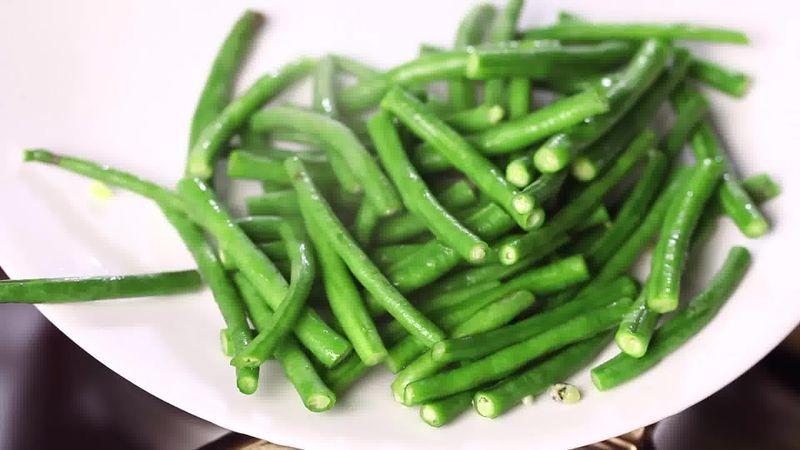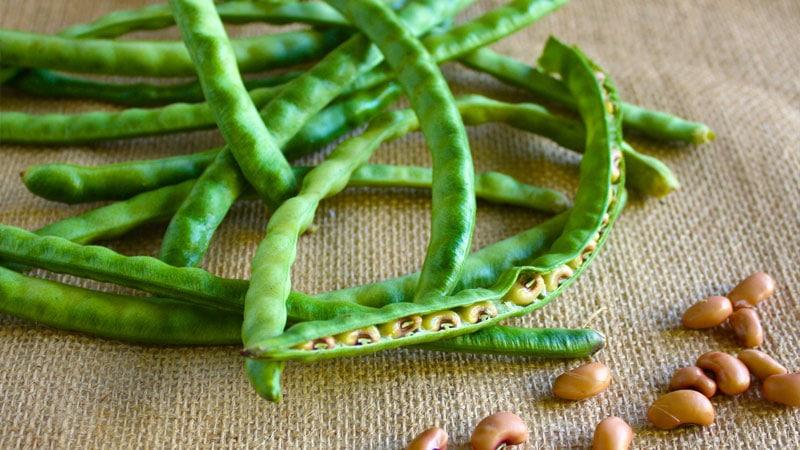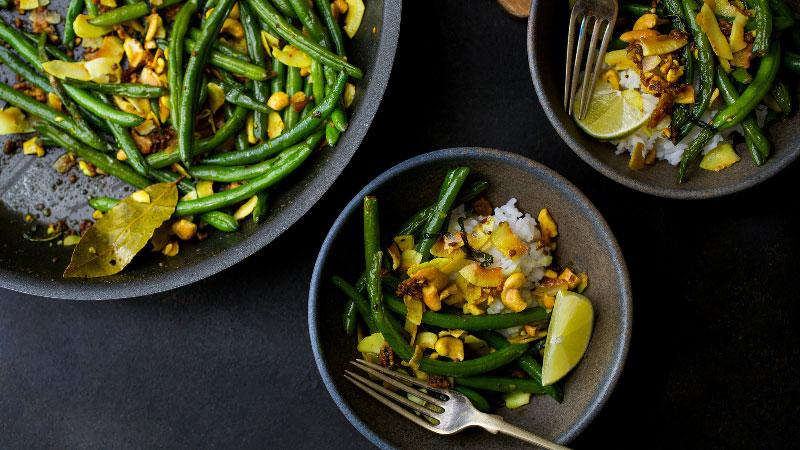Why are asparagus beans useful, how to grow and cook them correctly
Increasingly, healthy food advocates are choosing asparagus beans for their diet. It is also often called "pod". However, few people know what exactly it is useful for. In the article we will tell you what the benefits of asparagus beans are, about their cultivation and care, we will give several recipes that will diversify your menu.
The content of the article
What are Asparagus Beans
Some people ask themselves what is it - asparagus beans? These are unripe green shoots of common beans. Its pods are soft and can be easily eaten.
Why exactly "asparagus"? The thing is that shoots of this type of beans taste like asparagus. How exactly they look, look at the photo.

Composition and properties
If we talk about the beneficial properties of green beans, it is worth noting that they are a valuable source of vitamins A, C, group B, zinc, iron, magnesium, and potassium.
It has a diuretic effect and also helps to reduce weight, since its calorie content is only 24 kcal.
Asparagus beans also contain an easily digestible protein that the body needs.
The benefits of asparagus beans
This vegetable will be especially useful for patients with diabetes mellitus due to its arginine content. It is this amino acid that significantly improves the body's ability to absorb glucose. And due to their high fiber content, asparagus beans are considered indispensable in the fight against excess weight.
In addition to their obvious benefits and great taste, asparagus beans also aid garden maintenance. The presence of green beans in the garden scares away shrews and moles. Plant bean bushes around the perimeter of your property and close to other plants for solid protection from these pests.
The roots of bean plants reach more than a meter in length and ozonize the soil, which has a beneficial effect on the entire garden as a whole. That is why many summer residents plant asparagus beans shortly before planting other plants.
In addition to all of the above, the shoots of climbing species can be used as a decorative decoration for a wall of a house or a gazebo.
The best varieties of asparagus beans
Bean pods come in a variety of shades, ranging from greens and yellows to deep purples. The length of the pods varies from 12 to 120 cm. Also many varieties quite unpretentious, and can be grown in the shade and in the northern part of the site.
There are 3 types of asparagus beans:
- Shrub, growing up to 30-50 cm.
- Semi-climbing, growing up to 2 meters.
- Curly - from 2 to 5 meters.
"Laura"
Asparagus beans "Laura" are bushy species. One of the main advantages of this variety is its disease resistance and high yield. From the beginning of planting to harvesting, only 50-60 days pass, which makes it possible to classify the variety "Laura" as early maturing. The pods are uniformly yellowish in color, reaching 10-12 cm in length.
"Zhuravushka"
The asparagus bean "Zhuravushka" is a bushy plant variety, also belonging to the early maturing varieties. The average time for a crop to ripen takes 50 days. The height of the bushes varies in the region of 40-50 cm. The pods are slightly curved, green in color, and reach 11-13 cm in length. The "Zhuravushka" variety has a high yield.
"Snow Maiden"
Snegurochka asparagus beans are bushy. It ripens quite early - from the appearance of the first shoots to harvest, it takes about 45-50 days. The height of the bush does not exceed 40 cm. The pods reach 16 cm in length. They are painted yellowish-green and do not have a parchment layer and fibers.
"Saksa"
Saksa asparagus beans are a bushy plant with a high yield. This variety is early maturing, as it takes about 45-50 days to ripen. The height of the bushes reaches 35-40 cm, the pods are light green, 10-13 cm long.
reference... The Saksa variety was bred by Soviet scientists specifically for cultivation in the USSR. Therefore, this variety can be planted in cool climates. Remember that picking the Saksa variety must be green - in this case, they will be soft and juicy.
"Vigna"
Asparagus beans "Vigna" are semi-peeling and can reach up to a meter in length. This variety came to us from the Central part of Africa, but rather quickly fell in love with Russian summer residents. "Vigna" is used in the form of young shoots, since they contain many vitamins (A, B, C) and useful microelements.
Important! Vigna loves warmth, so it is better to start planting with growing seedlings, which are then planted in open ground. However, remember that if the average temperature in your area is below 20 degrees Celsius, there is a risk that the seedlings will not take root.

"Gerda"
Gerda asparagus beans reach a height of 3 meters. This variety of curly asparagus beans is ideal for decorating the exterior wall of a house or gazebo, as it requires vertical support to grow.
This variety is considered to be early maturing, it takes an average of 50 days to ripen. The plant does not require any special care. It is best to plant it in a sunny and well-sheltered place. Ripe pods can be up to 30 cm long. They grow in a pleasant pale yellow color.
"Fatima"
Asparagus beans "Fatima" are curly beans. The plant reaches 3 meters in height. The variety is considered a high-yielding and mid-season variety, as it takes up to 60 days to ripen.
Ripe pods are straight, light green in color, reaching a length of 25 cm. A feature of the "Fatima" variety is that it has a long fruiting period.
"Matilda"
Asparagus beans "Matilda" distinguish their dark purple color against the background of other varieties. This curly species can grow up to 3 meters in height, but do not forget about the vertical support. Fruit ripening lasts about 65 days, and the length of the pods reaches 20 cm.
How to grow asparagus beans on your site
A step-by-step action plan will allow you grow beans correctly and reap a rich harvest.
General recommendations
Caring for and growing asparagus beans does not require a lot of time and effort, but it is worth considering some features.
Since almost all varieties love warmth, choose a sunny side for planting. If you decide to grow a climbing species, do not forget to think about the necessary support for future shoots.
Attention! At temperatures below 10 ° C, young shoots stop growing, and at temperatures below zero they will die altogether.
Planting times may vary depending on where you live and the weather, but seeds are usually planted in the second half of May. In the northern regions, cultivation begins with harvesting seedlings. The most comfortable temperature for active growth is 20-25 degrees Celsius.
Soil preparation
It is better to start growing asparagus beans in the open field in the area where cabbage, potatoes or cucumbers previously grew. Loose, organic-rich soil will do. Also, make sure you have a suitable fertilizer 1-2 months before planting. Wood ash or potassium chloride are best suited for this.
Seed preparation
There are two ways to plant asparagus beans in the field. Most often, asparagus beans are sown in the ground as dry seeds.But before planting, the seeds can be soaked overnight in a growth stimulator. For this purpose, ash, manure or honey, which are diluted with water, are suitable. This mixture is poured over seeds covered with gauze.
How to plant seeds
Sprinkle ash on the planting site, mix with soil and sprinkle with water. After the water has been absorbed, the plants can be planted. Seeds of asparagus beans are placed in the ground to a depth of no more than 3-5 cm.For better growth, the distance between the seeds is 8-10 cm, and between the rows - 40-60 cm.
Top dressing
The first shoots begin to appear 5-7 days after planting. After about 4 weeks the soil can be fertilized again. Wood ash is ideal for this.
Harvesting
Since the pods are eaten unripe, it is important not to miss the harvest time. The best time for this is one to two weeks after the ovaries appear. Pods are harvested daily in batches of approximately the same age. Thus, you will give the opportunity to appear a new crop.
Read also:
How does beans affect the male, female and children's body?
Choose beans by color: which beans are healthier than white or red.
How to eat asparagus beans
Reviews about the taste of asparagus beans are always positive, so a rare housewife will refuse to have it on her table. Green beans are suitable for fresh consumption, canning and freezing.
To keep the beans fresh for the winter, wash and cut them into 2–3 cm pieces. Put them in boiling water for 1–2 minutes, then drain and pack the beans in a plastic container. In this form, it is ready to be frozen.

Recipes
Want to diversify your diet with interesting asparagus bean dishes, but don't know how? We will show you how to make it most tasty and healthy.
Korean salad
Ingredients for 4 servings:
- Asparagus beans - 200 g.
- Bulb onions - 70 g.
- Carrots - 100 g.
- Rice vinegar - 20 ml.
- Salt - 2 g.
- Sugar - 2 g.
- Garlic powder - 2 g.
- Ground coriander - 2 g.
- Ground red pepper - 2 g.
- Ground black pepper - 2 g.
Preparation:
- Wash the beans, cut the tails off both sides, then boil them in salted water for 7 minutes. After that, drain the beans into a colander, wait for all the water to drain, transfer it to a separate bowl and let cool.
- Wash the carrots, peel and chop into strips. Place it in a bowl of beans. Peel the onion, cut it into thin half rings and add it to the same bowl.
- Then add sugar, salt, rice vinegar and spices: garlic powder, ground coriander, black and red pepper. Add seasoning to taste - it is better to add a portion and taste, add more if necessary.
- Mix everything and put it in the refrigerator to marinate for a day.
Garnish "Spring"
An incredibly tasty, simple and budget side dish with a spicy sauce.
Ingredients:
- Green beans - 0.5 kg.
- Garlic - 2 cloves.
- Fresh, grated ginger - 1 tsp.
- Fresh chili pepper - 1/4 pcs.
- Olive oil - 2 tbsp. spoons.
- Soy sauce - 1 tbsp. the spoon.
- Wine or apple cider vinegar (or lemon juice) - 1 tbsp. the spoon.
- Greens to taste.
Preparation
Wash the green beans well, sort out, cut off the ends. Dip it in a saucepan of boiling, slightly salted water. Cook for 3-5 minutes. Then place them in a colander until the water is completely drained.
Combine oil, soy sauce, vinegar, finely chopped chili, garlic pressed through a press, and grated ginger.
Transfer the vegetables to a convenient bowl, pour over the sauce, mix well. Put in a heat-resistant dish and send to an oven preheated to 200 degrees. Bake for 10 minutes. Before serving, the finished dish can be sprinkled with herbs to taste.

Harm and contraindications
To get carried away with beans is not worth those who suffer from high acidity, gastritis, stomach or duodenal ulcers, as well as colitis, cholecystitis and gout. To avoid flatulence, it is advisable to drain the first water during cooking.
Conclusion
Asparagus beans are very healthy and nutritious. Moreover, it can be easily grown in your garden. It will especially appeal to those who monitor their health, since the regular use of asparagus beans helps in the fight against vitamin deficiency, especially in the winter season. Delicious and healthy harvests for you!